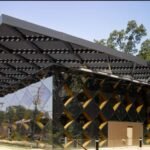The role of artificial intelligence in architectural design
Artificial Intelligence (AI) is transforming the field of architecture by introducing advanced technologies that streamline design processes, optimize building performance, and foster innovation. Here’s a comprehensive look at how AI is reshaping architectural design practices and its impact on the built environment.
1. Generative Design and Computational Creativity
Design Exploration:
- Algorithmic Design: Using AI algorithms to explore thousands of design options based on specified parameters, optimizing for various criteria such as structural integrity, energy efficiency, and aesthetic appeal.
- Iterative Refinement: Automating iterative design processes to generate novel solutions that push the boundaries of traditional design methodologies.
2. Predictive Analytics and Performance Optimization
Building Simulation:
- Environmental Analysis: Conducting simulations to predict building performance in different climates, optimizing natural lighting, ventilation, and energy consumption.
- Lifecycle Assessment: Analyzing environmental impacts and operational costs throughout the building lifecycle to inform design decisions and sustainability strategies.
3. Smart Building Technologies
AI-Driven Systems:
- Building Automation: Implementing AI-powered systems for HVAC (Heating, Ventilation, and Air Conditioning), lighting, and security to optimize energy use and occupant comfort.
- Occupant Experience: Personalizing building environments based on occupant preferences and behavior patterns captured through sensor data and IoT (Internet of Things) devices.
4. Robotics and Construction Automation

Robotic Fabrication:
- Prefabrication: Utilizing AI-guided robots for precision manufacturing of building components, reducing construction time and labor costs.
- On-Site Assembly: Automating assembly tasks such as bricklaying and 3D printing to enhance construction efficiency and quality control.
5. Design Assistance and Collaboration
Augmented Intelligence:
- Design Support Tools: Assisting architects with real-time design feedback, material selection, and regulatory compliance checks to streamline decision-making processes.
- Collaborative Platforms: Facilitating interdisciplinary collaboration among architects, engineers, and stakeholders through AI-enhanced project management and communication tools.
6. Ethical Considerations and Design Ethics
Ethical AI Use:
- Data Privacy: Safeguarding sensitive design data and personal information collected through AI-driven systems.
- Bias Mitigation: Addressing biases in AI algorithms to ensure equitable design outcomes and diversity in architectural solutions.
7. Education and Skill Development
Future Architectural Practices:
- AI Education: Integrating AI courses and workshops into architectural curricula to equip future architects with skills in computational design and digital fabrication.
- Continuous Learning: Embracing lifelong learning and professional development in AI technologies to stay abreast of industry advancements and emerging trends.
8. Regulatory Landscape and Standards
Industry Regulations:
- AI Ethics Guidelines: Adhering to ethical frameworks and industry standards for responsible AI deployment in architectural practice.
- Legal Compliance: Navigating regulatory frameworks governing AI use, data protection, and intellectual property rights in architectural design.
9. Sustainability and Resilience
Green Building Design:
- Climate Responsive Design: Leveraging AI to optimize building envelopes and passive design strategies for energy-efficient and resilient architecture.
- Circular Economy: Promoting material reuse, recycling, and sustainable practices through AI-enabled lifecycle analysis and waste reduction strategies.
10. Future Outlook and Innovation
AI-Driven Design Evolution:
- AI Creativity: Exploring the potential of AI to inspire new design paradigms and architectural expressions that blend human creativity with computational intelligence.
- Emerging Technologies: Anticipating advancements in AI, machine learning, and robotics that will continue to revolutionize architectural design and construction practices.
Conclusion
Artificial Intelligence is not just a tool but a transformative force in architectural design, offering architects unprecedented capabilities to innovate, optimize, and create sustainable and resilient built environments. By embracing AI-driven technologies and ethical principles, architects can harness the power of AI to address complex challenges, enhance design outcomes, and shape a more sustainable future for architecture and urban development. As AI continues to evolve, its integration into architectural practice promises to redefine creativity, efficiency, and environmental stewardship in the built environment.



